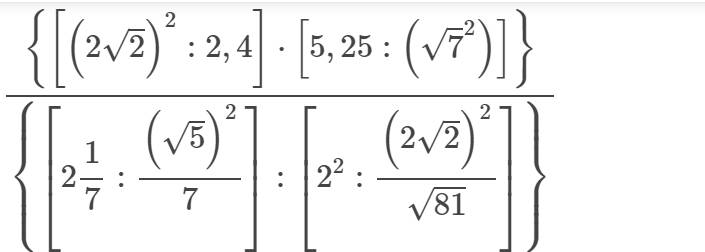Hãy nhập câu hỏi của bạn vào đây, nếu là tài khoản VIP, bạn sẽ được ưu tiên trả lời.

B1
a. = 7/3. ( 37/5 - 32/5)
= 7/3 . 1
= 7/3
![]() Phần b có gì đó sai sao lại có 3:+
Phần b có gì đó sai sao lại có 3:+
c. = 4 + 6 - 3 + 5
= 12
d. = -5/21 : -19/21 : 4/5
= 25/76
B2
a. 1/4 : x =1/2 - 3/4
x = -1/4
x = 1/4 : -1/4
x = -1
b. 2 . | 2x - 3 | = 4 - (-8)
2 . | 2x - 3| = 12
| 2x - 3 | = 12:2
| 2x - 3 | = 6
| x - 3 | = 6:2
| x - 3 | = 3
=> x - 3 = +- 3
* x - 3 = 3
x = 6
* x - 3 = -3
x = 0
Chúc bạn vui vẻ ![]()

1) Theo định nghĩa về căn bậc 2 số học thì đáp án là \(\sqrt{5^2}; \sqrt{(-5)^2}\)
2) Tập $Q$ là tập những số thực biểu diễn được dưới dạng \(\frac{a}{b}\) (a,b tự nhiên, $b$ khác $0$), tập $I$ là tập những số thực không biểu diễn được dạng như trên.
\(0,15=\frac{3}{20}\in\mathbb{Q}\) , A sai.
$\sqrt{2}$ là một số vô tỉ (tính chất quen thuộc), B sai.
$C$ hiển nhiên đúng, theo định nghĩa.
Do đó áp án đúng là C.
3)
a) \(-\sqrt{x}=(-7)^2=49\)
\(\Rightarrow \sqrt{x}=-49\) (vô lý, vì căn bậc 2 số học của một số là một số không âm , trong khi đó $-49$ âm)
Do đó pt vô nghiệm.
b) \(\sqrt{x+1}+2=0\Rightarrow \sqrt{x+1}=-2<0\)
Điều trên hoàn toàn vô lý do căn bậc 2 số học là một số không âm
Vậy pt vô nghiệm.
c) \(5\sqrt{x+1}+2=0\Rightarrow \sqrt{x+1}=\frac{-2}{5}<0\)
Điều trên hoàn toàn vô lý do căn bậc 2 số học là một số không âm
Vậy pt vô nghiệm.
d) \(\sqrt{2x-1}=29\Rightarrow 2x-1=29^2=841\Rightarrow x=\frac{841+1}{2}=421\)
e)\(x^2=0\Rightarrow x=\pm \sqrt{0}=0\)
g) \((x-1)^2=1\frac{9}{16}=\frac{25}{16}\)
\(\Rightarrow x-1=\pm \sqrt{\frac{25}{16}}=\pm \frac{5}{4}\)
\(\Rightarrow \left[\begin{matrix} x=\frac{9}{4}\\ x=\frac{-1}{4}\end{matrix}\right.\)
h) \(\sqrt{3-2x}=1\Rightarrow 3-2x=1^2=1\Rightarrow x=\frac{3-1}{2}=1\)
f) \(\sqrt{x}-x=0\Rightarrow \sqrt{x}=x\Rightarrow x=x^2\)
\(\Rightarrow x(1-x)=0\Rightarrow \left[\begin{matrix} x=0\\ x=1\end{matrix}\right.\)

a: \(=\left(\dfrac{1}{4}+\dfrac{3}{4}\right)\cdot\dfrac{18}{5}-\dfrac{6}{5}:\dfrac{-9}{5}+4\)
\(=\dfrac{18}{5}-\dfrac{6}{5}\cdot\dfrac{-5}{9}+4\)
\(=\dfrac{18}{5}+\dfrac{2}{3}+4\)
\(=\dfrac{124}{15}\)
b: \(=\dfrac{9}{25}\cdot\left(\dfrac{3}{5}-\dfrac{1}{5}+\dfrac{1}{2}\right)-\dfrac{3}{8}:\dfrac{9}{8}\)
\(=\dfrac{9}{25}\cdot\dfrac{4}{10}-\dfrac{1}{3}\)
\(=-\dfrac{71}{375}\)
c: \(=\dfrac{7}{10}:\dfrac{4}{5}+\dfrac{2}{9}:\dfrac{5}{9}+\dfrac{1}{8}\)
\(=\dfrac{7}{10}\cdot\dfrac{5}{4}+\dfrac{2}{5}+\dfrac{1}{8}\)
=1+2/5
=7/5
d: \(=\dfrac{3}{7}\left(19+\dfrac{1}{3}-33-\dfrac{1}{3}\right)-\dfrac{2}{7}=\dfrac{3}{7}\cdot\left(-14\right)-\dfrac{2}{7}=-6-\dfrac{2}{7}=\dfrac{-44}{7}\)
e: \(=\dfrac{2^{12}\cdot3^{10}+2^{12}\cdot3^{10}\cdot5}{-2^{11}\cdot3^{11}-2^{12}\cdot3^{12}}\)
\(=\dfrac{2^{12}\cdot3^{10}\cdot6}{-2^{11}\cdot3^{11}\left(1+2\cdot3\right)}=-\dfrac{2^{13}\cdot3^{11}}{2^{11}\cdot3^{11}\cdot7}=\dfrac{-4}{7}\)

Bài1:
Ta có:
a)\(\sqrt{\dfrac{3^2}{5^2}}=\sqrt{\dfrac{9}{25}}=\dfrac{3}{5}\)
b)\(\dfrac{\sqrt{3^2}+\sqrt{42^2}}{\sqrt{5^2}+\sqrt{70^2}}=\dfrac{\sqrt{9}+\sqrt{1764}}{\sqrt{25}+\sqrt{4900}}=\dfrac{3+42}{5+70}=\dfrac{45}{75}=\dfrac{3}{5}\)
c)\(\dfrac{\sqrt{3^2}-\sqrt{8^2}}{\sqrt{5^2}-\sqrt{8^2}}=\dfrac{\sqrt{9}-\sqrt{64}}{\sqrt{25}-\sqrt{64}}=\dfrac{3-8}{5-8}=\dfrac{-5}{-3}=\dfrac{5}{3}\)
Từ đó, suy ra: \(\dfrac{3}{5}=\sqrt{\dfrac{3^2}{5^2}}=\dfrac{\sqrt{3^2}+\sqrt{42^2}}{\sqrt{5^2}+\sqrt{70^2}}\)
Bài 2:
Không có đề bài à bạn?
Bài 3:
a)\(\sqrt{x}-1=4\)
\(\Rightarrow\sqrt{x}=5\)
\(\Rightarrow x=\sqrt{25}\)
\(\Rightarrow x=5\)
b)Vd:\(\sqrt{x^4}=\sqrt{x.x.x.x}=x^2\Rightarrow\sqrt{x^4}=x^2\)
Từ Vd suy ra:\(\sqrt{\left(x-1\right)^4}=16\)
\(\Rightarrow\left(x-1\right)^2=16\)
\(\Rightarrow\left(x-1\right)^2=4^2\)
\(\Rightarrow x-1=4\)
\(\Rightarrow x=5\)

a) x = \(\dfrac{-64}{3}\)
b) x = -3,5
c) x = 80
d) x = -1.162
e) x = 0,9436
g) x \(\in\varnothing\)
a) 16/3 : x = -1/4
=> x = 16/3 : (-1/4)
=> x = 16/3 . (-4)
=> x = -64/3
Vậy x= -64/3
b)2x - 13 = -8
=> 2x = (-8) + 1
=> 2x = -7
=> x = -7/2
d) 0,944 - 2x = 3,268
=> 2x = 0,944 - 3,268
=> 2x = -2,324
=> x = (-2,324) : 2
=> x = -1,162
g) \(\sqrt{5^2-3^2}=-\sqrt{81-x}\)
=> \(\sqrt{25-9}\)= \(-\sqrt{81-x}\)
=> \(\sqrt{16}\)=\(-\sqrt{81-x}\)
=> 4=\(-\sqrt{81-x}\)
tới đây mik bí r hk bt lm nữa

a)\(\sqrt{x}=4\Leftrightarrow x=4^2\Leftrightarrow x=16\)
b)\(\sqrt{x-2}=3\Leftrightarrow x-2=3^2\Leftrightarrow x=9-2=7\)
c)\(\sqrt{\dfrac{x}{3}-\dfrac{7}{6}}=\dfrac{1}{6}\Leftrightarrow\dfrac{x}{3}-\dfrac{7}{6}=\dfrac{1}{36}\Leftrightarrow\dfrac{x}{3}=-\dfrac{41}{36}\Leftrightarrow x=-\dfrac{41}{12}\)
d)\(x^2=7vớix< 0\)
\(\Leftrightarrow\left(-x\right)^2=7\Leftrightarrow-x=\sqrt{7}\Leftrightarrow x=-\sqrt{7}\)
e)\(x^2-4=0với>0\)
\(\Leftrightarrow x^2=4\Leftrightarrow x=\sqrt{4}=2\)
f)\(\left(2x+7\sqrt{7}\right)^2=7\)
\(\Leftrightarrow4x^2+\sqrt{5488}+343=7\)
\(\Leftrightarrow4x^2+\sqrt{5488}=-336\)
\(\Leftrightarrow4x^2=28\left(12-\sqrt{7}\right)\Leftrightarrow x^2=\dfrac{28\left(12-\sqrt{7}\right)}{4}=7\left(12-\sqrt{7}\right)\)
\(\Leftrightarrow x=\sqrt{7\left(12-\sqrt{7}\right)}=\sqrt{84-7\sqrt{7}}\)

a: =>1/6x=-49/60
=>x=-49/60:1/6=-49/60*6=-49/10
b: =>3/2x-1/5=3/2 hoặc 3/2x-1/5=-3/2
=>x=17/15 hoặc x=-13/15
c: =>1,25-4/5x=-5
=>4/5x=1,25+5=6,25
=>x=125/16
d: =>2^x*17=544
=>2^x=32
=>x=5
i: =>1/3x-4=4/5 hoặc 1/3x-4=-4/5
=>1/3x=4,8 hoặc 1/3x=-0,8+4=3,2
=>x=14,4 hoặc x=9,6
j: =>(2x-1)(2x+1)=0
=>x=1/2 hoặc x=-1/2

Bài 1:
a: \(\Leftrightarrow2-3\sqrt{x}+5\sqrt{x}=8\)
=>2 căn x=6
=>căn x=3
=>x=9
b: \(\Leftrightarrow\dfrac{1}{\sqrt{x}}\cdot\left(\dfrac{1}{2}+\dfrac{1}{3}-\dfrac{1}{6}\right)=\dfrac{2}{3}\)
\(\Leftrightarrow\dfrac{1}{\sqrt{x}}=\dfrac{2}{3}:\dfrac{2}{3}=1\)
=>x=1
a: Sửa đề: \(A=\dfrac{\sqrt{x}+1}{\sqrt{x}-3}\)
ĐKXĐ: \(\left\{{}\begin{matrix}x>=0\\x\ne9\end{matrix}\right.\)
Để A là số nguyên thì \(\sqrt{x}+1⋮\sqrt{x}-3\)
=>\(\sqrt{x}-3+4⋮\sqrt{x}-3\)
=>\(4⋮\sqrt{x}-3\)
=>\(\sqrt{x}-3\in\left\{1;-1;2;-2;4;-4\right\}\)
=>\(\sqrt{x}\in\left\{4;2;5;1;7;-1\right\}\)
=>\(\sqrt{x}\in\left\{4;2;5;1;7\right\}\)
=>\(x\in\left\{16;4;25;1;49\right\}\)
b: